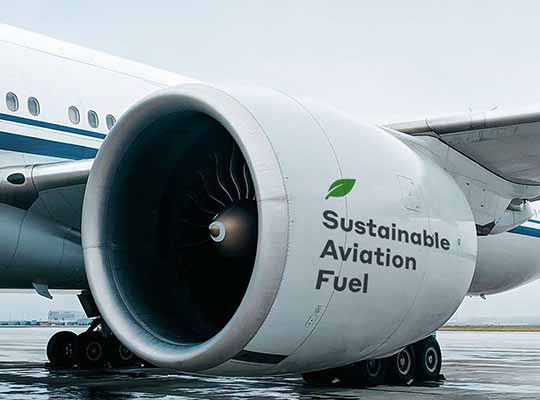CHICAGO — According to the new research report the “Sustainable Aviation Fuel Market by Fuel Type (Biofuel, Hydrogen Fuel, Power to Liquid Fuel, Gas to Liquid), Biofuel Manufacturing Technology (FT-SPK, HEFA-SPK, ATJ-SPK, HFS-SIP, CHJ), Biofuel Blending Capacity, Platform, Region – Global Forecast to 2030”, published by MarketsandMarkets, the market is estimated at USD 219 million in 2021 and is expected to reach USD 15,716 million by 2030, at a CAGR of 60.8% during the forecast period. The increasing need for reduction in greenhouse gas emissions, increasing air passenger traffic, and high fuel efficiency of biofuels are some of the key factors driving the Sustainable Aviation Fuel Market. The government initiatives such as tax reductions on the use of green and clean aviation fuels will drive the growth of sustainable aviation fuel in future.
Based on fuel type, biofuel is expected to account the largest share in the Sustainable Aviation Fuel Market in 2020
By type, the Sustainable Aviation Fuel Market has been segmented into biofuel, hydrogen fuel, and power-to-liquid. The biofuel segment is estimated to account for the largest share during the forecast period. Achieving the GHG emissions reduction targets proposed by the aviation industry and by organizations such as the International Civil Aviation Organization (ICAO) will require a significant increase in biofuel production and consumption, thus driving the market. In addition, drop-in capability with no changes in infrastructure of aircraft drives demand for biofuel.
Based on biofuel manufacturing technology, the hydroprocessed fatty acid esters and fatty acids – synthetic paraffinic kerosene (HEFA-SPK) segment is projected to lead the Sustainable Aviation Fuel Market during the forecast period
By biofuel manufacturing technology, the Sustainable Aviation Fuel Market is segmented into Hydroprocessed Fatty Acid Esters and Fatty Acids – Synthetic Paraffinic Kerosene (HEFA-SPK), Fischer Tropsch Synthetic Paraffinic Kerosene (FT-SPK), Synthetic Iso-paraffin from Fermented Hydroprocessed Sugar (HFS-SIP), Alcohol to Jet SPK (ATJ-SPK), and Catalytic Hydrothermolysis Jet (CHJ). Hydroprocessed Fatty Acid Esters and Fatty Acids – Synthetic Paraffinic Kerosene (HEFA-SPK). Hydroprocessed Fatty Acid Esters and Fatty Acids – Synthetic Paraffinic Kerosene (HEFA-SPK) is projected to lead the Sustainable Aviation Fuel Market during the forecast period. This growth can be attributed to the most commercially available biofuels produced are from this technology.
Based on biofuel blending capacity, the 30% to 50% segment of the Sustainable Aviation Fuel Market is projected to grow at the highest CAGR during the forecast period
Based on biofuel blending capacity, the Sustainable Aviation Fuel Market is segmented into below 30%, 30% to 50%, and above 50%. The 30% to 50% segment is projected to grow at the highest CAGR during the forecast period. The increasing concerns of the climate change will drive the demand for a larger blending capacity of renewable jet fuel with the conventional jet fuel. There has been various initiatives taken by the airlines to test and implement the blended fuel in their aircraft fleet. For instance, in June 2019, United Airlines took a flight from Chicago O’Hare to Los Angeles, powered by a 30% blend of sustainable aviation fuel produced by World Energy. The blended fuel met the same fuel specifications as Jet A with additional environmental benefits.
Based on platform, the military aviation segment of the Sustainable Aviation Fuel Market is projected to grow at the highest CAGR during the forecast period
Based on platform, the Sustainable Aviation Fuel Market is segmented into commercial aviation, military aviation, business & general aviation, and unmanned aerial vehicle. The military aviation segment is projected to grow at the highest CAGR during the forecast period. The defense sector is expected to be the fastest-growing segment among the different platforms, owing to the increasing government focus on promoting bio-jet fuels in the defense/military sector, particularly in the US, the Netherlands, and India.
North America has the highest CAGR during the forecast period
North America has the highest CAGR. The North American market has been studied for the US and Canada. The region is considered to have the largest number of aircraft fleet with a large number of passengers per year, leading to increase in aircraft emissions substantially. To cater to the need for reduction in carbon footprints due to increasing air traffic and air passengers, countries such as the US and Canada are focused on various initiatives to utilize sustainable aviation fuel. With supportive policies and initiatives to decarbonize aviation emissions, the North American market is deemed to be one of the strong demand centers for sustainable aviation fuel. The number of sustainable aviation fuel initiatives taken by countries within the region such as US and Canada are Commercial Aviation Alternative Fuel Initiative (CAAFI), Midwest Aviation Sustainable Biofuels Initiative (MASBI), and Canada’s Biojet Supply Chain Initiative, among others.
Major players operating in the renewable jet fuel market Neste (Finland), TotalEnergies (France), World Energy (US), Fulcrum BioEnergy (US), and LanzaTech (US) among others. These key players offer various products and services such as biofuel, synthetic fuel, e-fuels, green fuel, and hydrogen fuel, in order to curb the GHG emissions from the aviation and other industrial sectors such as automotive, marine, chemical etc. The startup companies in the Sustainable Aviation Fuel Market include Preem (Sweden), OMV (Austria), Atmosfair (Germany), Wastefuel (US), Prometheus Fuels (US) Red Rocks Biofuel (US), Northwest Advanced Biofuels (Austria). These startups are collaborating with various stakeholders of the aviation fuel industry to contribute towards the ambitious goals of GHG emission reductions from the aviation and other industrial sectors.











